Managing Communication, Knowledge, and Information: A Report
VerifiedAdded on 2020/01/21
|11
|2830
|116
Report
AI Summary
This report provides a comprehensive analysis of managing communication, knowledge, and information within an organizational context, using Google as a case study. It explores the range of decisions a company like Google must make, examining the information and knowledge required for effective decision-making at strategic, tactical, and operational levels. The report assesses both internal and external sources of information, including financial documents, personnel records, government websites, and research publications. It also recommends improvements for the management team, such as adopting a Continuing Professional Development (CPD) model. Furthermore, the report identifies key stakeholders, outlines strategies for effective communication and engagement, and discusses methods for information collection, storage, and dissemination. Strategies to make events memorable are also provided. Overall, the report emphasizes the importance of systematic information management for organizational success, especially with the opening of a new store.
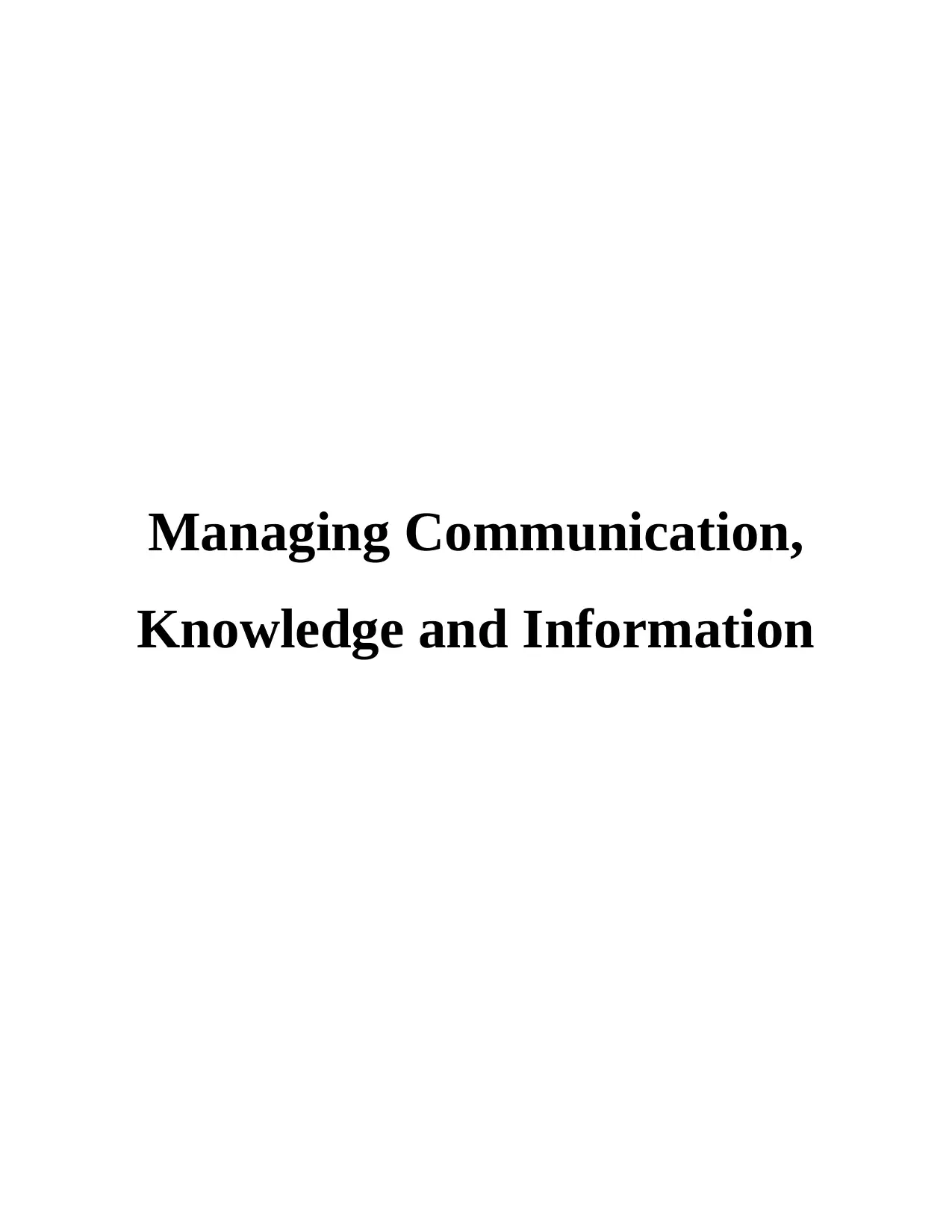
Managing Communication,
Knowledge and Information
Knowledge and Information
Paraphrase This Document
Need a fresh take? Get an instant paraphrase of this document with our AI Paraphraser

TABLE OF CONTENTS
INTRODUCTION...........................................................................................................................1
TASK 1............................................................................................................................................1
1.1 Range of decisions to be taken by company....................................................................1
1.2 Examining information and knowledge needed to ensure effective decision making.....2
1.3 Assessment of internal and external sources of information and understanding.............2
1.4 Recommendations for improvement of management team..............................................3
TASK 2............................................................................................................................................4
2.1 Identifying stakeholders for decision making process.....................................................4
2.2 Establishing contact with the stakeholders through various modes.................................4
2.3 Involving the stakeholders in decision-making................................................................5
2.4 Designing strategies to make the event memorable ........................................................6
TASK 4............................................................................................................................................6
4.1 Approach for collection, storage and dissemination of information................................6
4.2 Improvements in collection, storage and dissemination of information..........................6
4.3 Various strategies to improve system of information and knowledge ............................7
CONCLUSION ...............................................................................................................................7
REFERENCES................................................................................................................................8
INTRODUCTION...........................................................................................................................1
TASK 1............................................................................................................................................1
1.1 Range of decisions to be taken by company....................................................................1
1.2 Examining information and knowledge needed to ensure effective decision making.....2
1.3 Assessment of internal and external sources of information and understanding.............2
1.4 Recommendations for improvement of management team..............................................3
TASK 2............................................................................................................................................4
2.1 Identifying stakeholders for decision making process.....................................................4
2.2 Establishing contact with the stakeholders through various modes.................................4
2.3 Involving the stakeholders in decision-making................................................................5
2.4 Designing strategies to make the event memorable ........................................................6
TASK 4............................................................................................................................................6
4.1 Approach for collection, storage and dissemination of information................................6
4.2 Improvements in collection, storage and dissemination of information..........................6
4.3 Various strategies to improve system of information and knowledge ............................7
CONCLUSION ...............................................................................................................................7
REFERENCES................................................................................................................................8

INDEX OF TABLES
Table 1: Three levels of information...............................................................................................2
Table 1: Three levels of information...............................................................................................2
⊘ This is a preview!⊘
Do you want full access?
Subscribe today to unlock all pages.

Trusted by 1+ million students worldwide
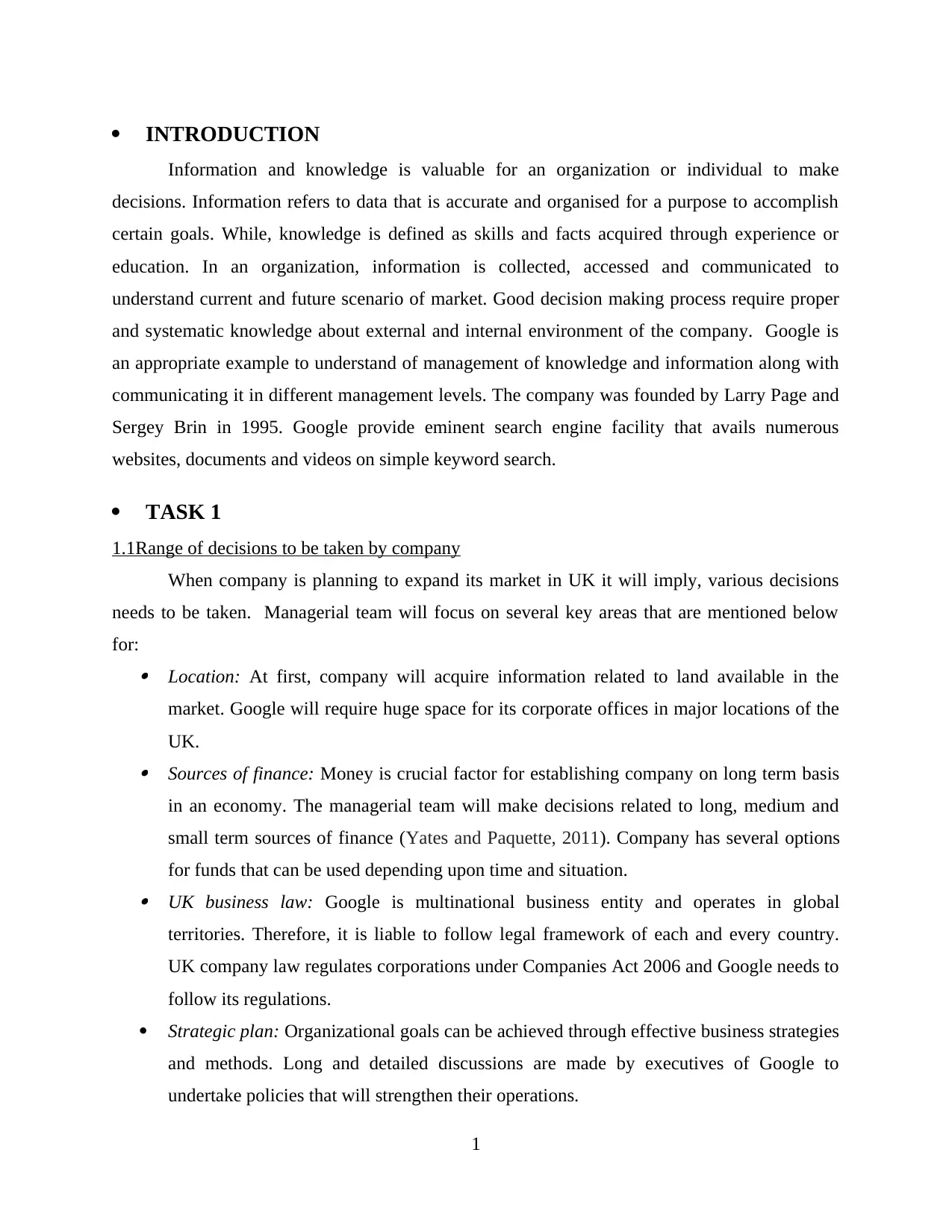
INTRODUCTION
Information and knowledge is valuable for an organization or individual to make
decisions. Information refers to data that is accurate and organised for a purpose to accomplish
certain goals. While, knowledge is defined as skills and facts acquired through experience or
education. In an organization, information is collected, accessed and communicated to
understand current and future scenario of market. Good decision making process require proper
and systematic knowledge about external and internal environment of the company. Google is
an appropriate example to understand of management of knowledge and information along with
communicating it in different management levels. The company was founded by Larry Page and
Sergey Brin in 1995. Google provide eminent search engine facility that avails numerous
websites, documents and videos on simple keyword search.
TASK 1
1.1Range of decisions to be taken by company
When company is planning to expand its market in UK it will imply, various decisions
needs to be taken. Managerial team will focus on several key areas that are mentioned below
for: Location: At first, company will acquire information related to land available in the
market. Google will require huge space for its corporate offices in major locations of the
UK. Sources of finance: Money is crucial factor for establishing company on long term basis
in an economy. The managerial team will make decisions related to long, medium and
small term sources of finance (Yates and Paquette, 2011). Company has several options
for funds that can be used depending upon time and situation. UK business law: Google is multinational business entity and operates in global
territories. Therefore, it is liable to follow legal framework of each and every country.
UK company law regulates corporations under Companies Act 2006 and Google needs to
follow its regulations.
Strategic plan: Organizational goals can be achieved through effective business strategies
and methods. Long and detailed discussions are made by executives of Google to
undertake policies that will strengthen their operations.
1
Information and knowledge is valuable for an organization or individual to make
decisions. Information refers to data that is accurate and organised for a purpose to accomplish
certain goals. While, knowledge is defined as skills and facts acquired through experience or
education. In an organization, information is collected, accessed and communicated to
understand current and future scenario of market. Good decision making process require proper
and systematic knowledge about external and internal environment of the company. Google is
an appropriate example to understand of management of knowledge and information along with
communicating it in different management levels. The company was founded by Larry Page and
Sergey Brin in 1995. Google provide eminent search engine facility that avails numerous
websites, documents and videos on simple keyword search.
TASK 1
1.1Range of decisions to be taken by company
When company is planning to expand its market in UK it will imply, various decisions
needs to be taken. Managerial team will focus on several key areas that are mentioned below
for: Location: At first, company will acquire information related to land available in the
market. Google will require huge space for its corporate offices in major locations of the
UK. Sources of finance: Money is crucial factor for establishing company on long term basis
in an economy. The managerial team will make decisions related to long, medium and
small term sources of finance (Yates and Paquette, 2011). Company has several options
for funds that can be used depending upon time and situation. UK business law: Google is multinational business entity and operates in global
territories. Therefore, it is liable to follow legal framework of each and every country.
UK company law regulates corporations under Companies Act 2006 and Google needs to
follow its regulations.
Strategic plan: Organizational goals can be achieved through effective business strategies
and methods. Long and detailed discussions are made by executives of Google to
undertake policies that will strengthen their operations.
1
Paraphrase This Document
Need a fresh take? Get an instant paraphrase of this document with our AI Paraphraser

1.2 Examining information and knowledge needed to ensure effective decision making
Organizations determine and evaluate information so that effective decisions can be
undertaken (Borghoff and Pareschi, 2013). Google also adopts a model that segments knowledge
according to short and long run operations. There are three levels of information that can be
understood by below given table:
Table 1: Levels of information
Strategic information It consists of information used to make long term decisions and
strategies like government policy, competitor analysis, capital
equipments' requirement and future market prospects.
Tactical information This knowledge will be acquired through strategic information. Here,
middle level management focuses on decisions related to budgetary
control, stock turnover and cash flow forecasts. It also includes
statistical information about labour turnover and short term
purchasing requirements.
Operational
information
Plans and procedures framed by middle level management are used in
operational information. It deals in short term or daily proceedings of
Google. Decisions are taken related to employee hours worked, stock
levels and raw materials input to production process (Coombs, 2014)
Through these different levels of information and knowledge, Google undertakes
effective decision making process. Proper analysis of every task provides better results in
comparison with inappropriate data collection and assessment process.
1.3 Assessment of internal and external sources of information and understanding
The executives and managers of Google determine essential information to plan
strategies for the company. The information is generated through various channels that can be
classified as internal and external sources. Primary information, facts and figures that are
acquired from inside the company are internal sources. On the other hand, relevant data received
from outside the organization is external source of information. Both these classifications are
specified below:
2
Organizations determine and evaluate information so that effective decisions can be
undertaken (Borghoff and Pareschi, 2013). Google also adopts a model that segments knowledge
according to short and long run operations. There are three levels of information that can be
understood by below given table:
Table 1: Levels of information
Strategic information It consists of information used to make long term decisions and
strategies like government policy, competitor analysis, capital
equipments' requirement and future market prospects.
Tactical information This knowledge will be acquired through strategic information. Here,
middle level management focuses on decisions related to budgetary
control, stock turnover and cash flow forecasts. It also includes
statistical information about labour turnover and short term
purchasing requirements.
Operational
information
Plans and procedures framed by middle level management are used in
operational information. It deals in short term or daily proceedings of
Google. Decisions are taken related to employee hours worked, stock
levels and raw materials input to production process (Coombs, 2014)
Through these different levels of information and knowledge, Google undertakes
effective decision making process. Proper analysis of every task provides better results in
comparison with inappropriate data collection and assessment process.
1.3 Assessment of internal and external sources of information and understanding
The executives and managers of Google determine essential information to plan
strategies for the company. The information is generated through various channels that can be
classified as internal and external sources. Primary information, facts and figures that are
acquired from inside the company are internal sources. On the other hand, relevant data received
from outside the organization is external source of information. Both these classifications are
specified below:
2

Internal source of information
Generally, interior data collection comprises financial documents, personal records, sales
figures and customer records (Unwin, 2012). Financial information is related to performance and
profitability of the company and it is analysed by financial accountant or controller of Google.
While, personnel information relates to all database of managers and employees of concerned
group. Company makes use of personnel details to understand working culture and employee
turnover every year. Sales information determines units of products and services consumed in
target market.
External source of information
Google obtains its organizational details from outside its premises through government
websites, newspapers and magazines, researchers and the internet. Information acquired from
government authorities is reliable and effective for Google. It also relies on database and
research work performed by individuals or groups to receive the latest facts and figures. Google
now-a-days makes use of internet services to acquire information for company's benefit (Unwin,
2012).
1.4 Recommendations for improvement of management team
With appropriate collection of data, information and knowledge, Google management
team can make effective decisions. The company should focus on searching new and modified
techniques to formulate business operations in much better manner. The managerial team should
adopt Continuing Professional Development (CPD) model that will help them to maintain their
knowledge and skills related to professional lives. The managers should include formal types of
vocational education, post-secondary or poly-technical training developing their managerial
skills. Various tools and techniques like coaching, consulting, case study method, mentoring can
be adopted to ensure proper knowledge and experience (Dalkir, 2013). These two are essential
factors for any individual to sustain in highly competitive environment.
Consultation provides clarification to managers about critical situation along with
frequent remedies to the problem. Secondly, coaching and mentoring guides professional or
Google's managers to develop individual awareness and refine his own professional knowledge.
Observation, reflection and action help to enhance manager’s competencies in specific skill. In
3
Generally, interior data collection comprises financial documents, personal records, sales
figures and customer records (Unwin, 2012). Financial information is related to performance and
profitability of the company and it is analysed by financial accountant or controller of Google.
While, personnel information relates to all database of managers and employees of concerned
group. Company makes use of personnel details to understand working culture and employee
turnover every year. Sales information determines units of products and services consumed in
target market.
External source of information
Google obtains its organizational details from outside its premises through government
websites, newspapers and magazines, researchers and the internet. Information acquired from
government authorities is reliable and effective for Google. It also relies on database and
research work performed by individuals or groups to receive the latest facts and figures. Google
now-a-days makes use of internet services to acquire information for company's benefit (Unwin,
2012).
1.4 Recommendations for improvement of management team
With appropriate collection of data, information and knowledge, Google management
team can make effective decisions. The company should focus on searching new and modified
techniques to formulate business operations in much better manner. The managerial team should
adopt Continuing Professional Development (CPD) model that will help them to maintain their
knowledge and skills related to professional lives. The managers should include formal types of
vocational education, post-secondary or poly-technical training developing their managerial
skills. Various tools and techniques like coaching, consulting, case study method, mentoring can
be adopted to ensure proper knowledge and experience (Dalkir, 2013). These two are essential
factors for any individual to sustain in highly competitive environment.
Consultation provides clarification to managers about critical situation along with
frequent remedies to the problem. Secondly, coaching and mentoring guides professional or
Google's managers to develop individual awareness and refine his own professional knowledge.
Observation, reflection and action help to enhance manager’s competencies in specific skill. In
3
⊘ This is a preview!⊘
Do you want full access?
Subscribe today to unlock all pages.

Trusted by 1+ million students worldwide

modern time, online mode personal development available in the form of web information can
improve the effectiveness of mangers.
TASK 2
2.1 Identifying stakeholders for decision making process
Stakeholders are group of individuals who are directly or indirectly affected by actions
and policies of the company. Their participation in organization not only improves efficiency of
the company but provides opportunities to expand their market (Nonaka, 2015).
Internal stakeholders
It consists of those stakeholders who work internally in the organization and includes
shareholders, employees and management. Owners and shareholders are responsible to invest
capital in the company while, mangers are responsible to frame plans and policies for Google.
Management includes top, middle and lower level managers who work all together for growth
and expansion of company (Ajmal, Helo and Kekäle, 201). Employees are responsible to
implement plans and strategies framed by top level executives.
External stakeholders
The external stakeholders include government, suppliers, creditors and customers.
Government acts as regulator and monitor of market conditions for company. Legal guidelines
and taxation policies help managers to plan policies accordingly. Other stakeholders of Google
are creditors and suppliers that provide funds and optimum resources respectively to concerned
corporation. Customers are considered as essential part of stakeholders for the company as they
determine performance of Google in market.
4
Illustration 1: Types of stakeholders
improve the effectiveness of mangers.
TASK 2
2.1 Identifying stakeholders for decision making process
Stakeholders are group of individuals who are directly or indirectly affected by actions
and policies of the company. Their participation in organization not only improves efficiency of
the company but provides opportunities to expand their market (Nonaka, 2015).
Internal stakeholders
It consists of those stakeholders who work internally in the organization and includes
shareholders, employees and management. Owners and shareholders are responsible to invest
capital in the company while, mangers are responsible to frame plans and policies for Google.
Management includes top, middle and lower level managers who work all together for growth
and expansion of company (Ajmal, Helo and Kekäle, 201). Employees are responsible to
implement plans and strategies framed by top level executives.
External stakeholders
The external stakeholders include government, suppliers, creditors and customers.
Government acts as regulator and monitor of market conditions for company. Legal guidelines
and taxation policies help managers to plan policies accordingly. Other stakeholders of Google
are creditors and suppliers that provide funds and optimum resources respectively to concerned
corporation. Customers are considered as essential part of stakeholders for the company as they
determine performance of Google in market.
4
Illustration 1: Types of stakeholders
Paraphrase This Document
Need a fresh take? Get an instant paraphrase of this document with our AI Paraphraser
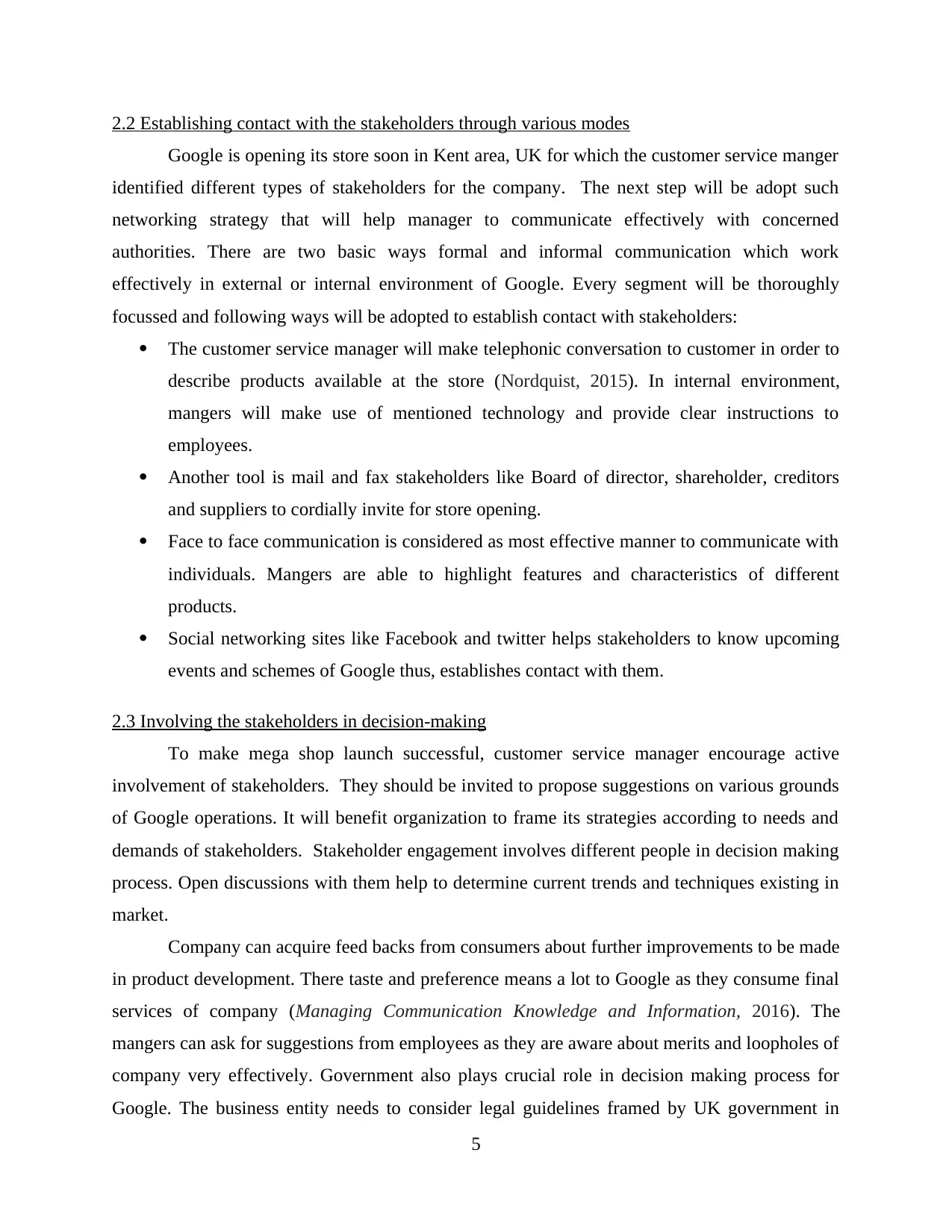
2.2 Establishing contact with the stakeholders through various modes
Google is opening its store soon in Kent area, UK for which the customer service manger
identified different types of stakeholders for the company. The next step will be adopt such
networking strategy that will help manager to communicate effectively with concerned
authorities. There are two basic ways formal and informal communication which work
effectively in external or internal environment of Google. Every segment will be thoroughly
focussed and following ways will be adopted to establish contact with stakeholders:
The customer service manager will make telephonic conversation to customer in order to
describe products available at the store (Nordquist, 2015). In internal environment,
mangers will make use of mentioned technology and provide clear instructions to
employees.
Another tool is mail and fax stakeholders like Board of director, shareholder, creditors
and suppliers to cordially invite for store opening.
Face to face communication is considered as most effective manner to communicate with
individuals. Mangers are able to highlight features and characteristics of different
products.
Social networking sites like Facebook and twitter helps stakeholders to know upcoming
events and schemes of Google thus, establishes contact with them.
2.3 Involving the stakeholders in decision-making
To make mega shop launch successful, customer service manager encourage active
involvement of stakeholders. They should be invited to propose suggestions on various grounds
of Google operations. It will benefit organization to frame its strategies according to needs and
demands of stakeholders. Stakeholder engagement involves different people in decision making
process. Open discussions with them help to determine current trends and techniques existing in
market.
Company can acquire feed backs from consumers about further improvements to be made
in product development. There taste and preference means a lot to Google as they consume final
services of company (Managing Communication Knowledge and Information, 2016). The
mangers can ask for suggestions from employees as they are aware about merits and loopholes of
company very effectively. Government also plays crucial role in decision making process for
Google. The business entity needs to consider legal guidelines framed by UK government in
5
Google is opening its store soon in Kent area, UK for which the customer service manger
identified different types of stakeholders for the company. The next step will be adopt such
networking strategy that will help manager to communicate effectively with concerned
authorities. There are two basic ways formal and informal communication which work
effectively in external or internal environment of Google. Every segment will be thoroughly
focussed and following ways will be adopted to establish contact with stakeholders:
The customer service manager will make telephonic conversation to customer in order to
describe products available at the store (Nordquist, 2015). In internal environment,
mangers will make use of mentioned technology and provide clear instructions to
employees.
Another tool is mail and fax stakeholders like Board of director, shareholder, creditors
and suppliers to cordially invite for store opening.
Face to face communication is considered as most effective manner to communicate with
individuals. Mangers are able to highlight features and characteristics of different
products.
Social networking sites like Facebook and twitter helps stakeholders to know upcoming
events and schemes of Google thus, establishes contact with them.
2.3 Involving the stakeholders in decision-making
To make mega shop launch successful, customer service manager encourage active
involvement of stakeholders. They should be invited to propose suggestions on various grounds
of Google operations. It will benefit organization to frame its strategies according to needs and
demands of stakeholders. Stakeholder engagement involves different people in decision making
process. Open discussions with them help to determine current trends and techniques existing in
market.
Company can acquire feed backs from consumers about further improvements to be made
in product development. There taste and preference means a lot to Google as they consume final
services of company (Managing Communication Knowledge and Information, 2016). The
mangers can ask for suggestions from employees as they are aware about merits and loopholes of
company very effectively. Government also plays crucial role in decision making process for
Google. The business entity needs to consider legal guidelines framed by UK government in
5
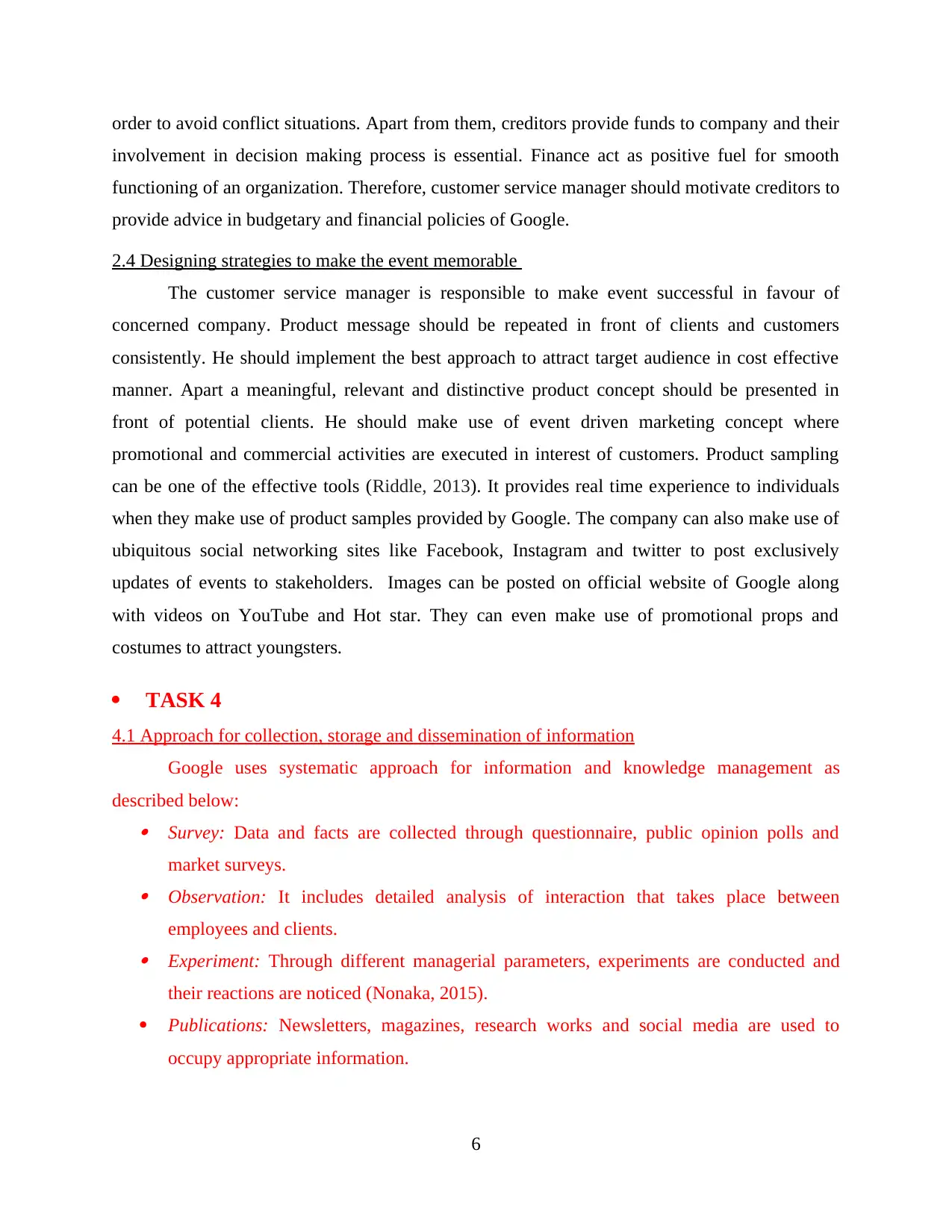
order to avoid conflict situations. Apart from them, creditors provide funds to company and their
involvement in decision making process is essential. Finance act as positive fuel for smooth
functioning of an organization. Therefore, customer service manager should motivate creditors to
provide advice in budgetary and financial policies of Google.
2.4 Designing strategies to make the event memorable
The customer service manager is responsible to make event successful in favour of
concerned company. Product message should be repeated in front of clients and customers
consistently. He should implement the best approach to attract target audience in cost effective
manner. Apart a meaningful, relevant and distinctive product concept should be presented in
front of potential clients. He should make use of event driven marketing concept where
promotional and commercial activities are executed in interest of customers. Product sampling
can be one of the effective tools (Riddle, 2013). It provides real time experience to individuals
when they make use of product samples provided by Google. The company can also make use of
ubiquitous social networking sites like Facebook, Instagram and twitter to post exclusively
updates of events to stakeholders. Images can be posted on official website of Google along
with videos on YouTube and Hot star. They can even make use of promotional props and
costumes to attract youngsters.
TASK 4
4.1 Approach for collection, storage and dissemination of information
Google uses systematic approach for information and knowledge management as
described below: Survey: Data and facts are collected through questionnaire, public opinion polls and
market surveys. Observation: It includes detailed analysis of interaction that takes place between
employees and clients. Experiment: Through different managerial parameters, experiments are conducted and
their reactions are noticed (Nonaka, 2015).
Publications: Newsletters, magazines, research works and social media are used to
occupy appropriate information.
6
involvement in decision making process is essential. Finance act as positive fuel for smooth
functioning of an organization. Therefore, customer service manager should motivate creditors to
provide advice in budgetary and financial policies of Google.
2.4 Designing strategies to make the event memorable
The customer service manager is responsible to make event successful in favour of
concerned company. Product message should be repeated in front of clients and customers
consistently. He should implement the best approach to attract target audience in cost effective
manner. Apart a meaningful, relevant and distinctive product concept should be presented in
front of potential clients. He should make use of event driven marketing concept where
promotional and commercial activities are executed in interest of customers. Product sampling
can be one of the effective tools (Riddle, 2013). It provides real time experience to individuals
when they make use of product samples provided by Google. The company can also make use of
ubiquitous social networking sites like Facebook, Instagram and twitter to post exclusively
updates of events to stakeholders. Images can be posted on official website of Google along
with videos on YouTube and Hot star. They can even make use of promotional props and
costumes to attract youngsters.
TASK 4
4.1 Approach for collection, storage and dissemination of information
Google uses systematic approach for information and knowledge management as
described below: Survey: Data and facts are collected through questionnaire, public opinion polls and
market surveys. Observation: It includes detailed analysis of interaction that takes place between
employees and clients. Experiment: Through different managerial parameters, experiments are conducted and
their reactions are noticed (Nonaka, 2015).
Publications: Newsletters, magazines, research works and social media are used to
occupy appropriate information.
6
⊘ This is a preview!⊘
Do you want full access?
Subscribe today to unlock all pages.

Trusted by 1+ million students worldwide
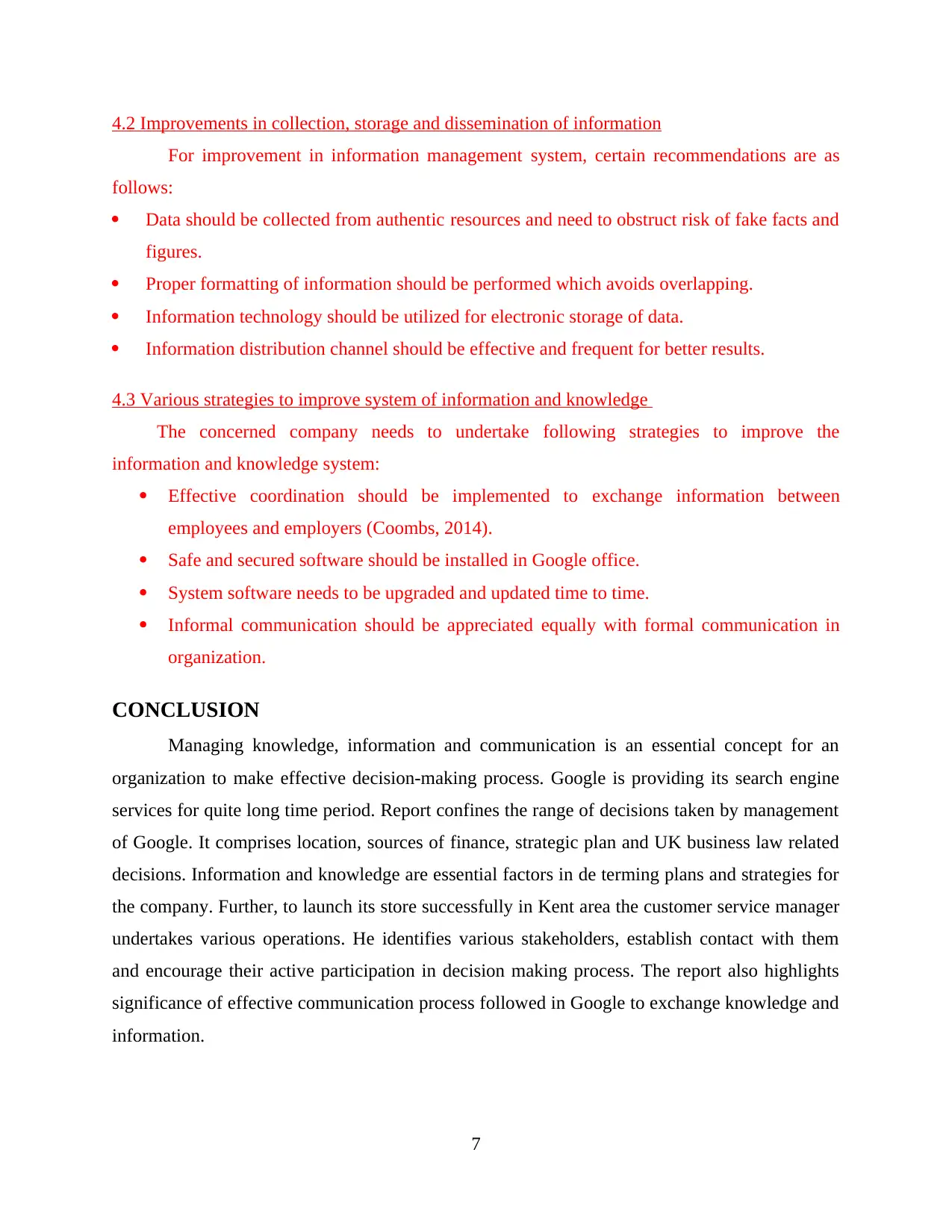
4.2 Improvements in collection, storage and dissemination of information
For improvement in information management system, certain recommendations are as
follows:
Data should be collected from authentic resources and need to obstruct risk of fake facts and
figures.
Proper formatting of information should be performed which avoids overlapping.
Information technology should be utilized for electronic storage of data.
Information distribution channel should be effective and frequent for better results.
4.3 Various strategies to improve system of information and knowledge
The concerned company needs to undertake following strategies to improve the
information and knowledge system:
Effective coordination should be implemented to exchange information between
employees and employers (Coombs, 2014).
Safe and secured software should be installed in Google office.
System software needs to be upgraded and updated time to time.
Informal communication should be appreciated equally with formal communication in
organization.
CONCLUSION
Managing knowledge, information and communication is an essential concept for an
organization to make effective decision-making process. Google is providing its search engine
services for quite long time period. Report confines the range of decisions taken by management
of Google. It comprises location, sources of finance, strategic plan and UK business law related
decisions. Information and knowledge are essential factors in de terming plans and strategies for
the company. Further, to launch its store successfully in Kent area the customer service manager
undertakes various operations. He identifies various stakeholders, establish contact with them
and encourage their active participation in decision making process. The report also highlights
significance of effective communication process followed in Google to exchange knowledge and
information.
7
For improvement in information management system, certain recommendations are as
follows:
Data should be collected from authentic resources and need to obstruct risk of fake facts and
figures.
Proper formatting of information should be performed which avoids overlapping.
Information technology should be utilized for electronic storage of data.
Information distribution channel should be effective and frequent for better results.
4.3 Various strategies to improve system of information and knowledge
The concerned company needs to undertake following strategies to improve the
information and knowledge system:
Effective coordination should be implemented to exchange information between
employees and employers (Coombs, 2014).
Safe and secured software should be installed in Google office.
System software needs to be upgraded and updated time to time.
Informal communication should be appreciated equally with formal communication in
organization.
CONCLUSION
Managing knowledge, information and communication is an essential concept for an
organization to make effective decision-making process. Google is providing its search engine
services for quite long time period. Report confines the range of decisions taken by management
of Google. It comprises location, sources of finance, strategic plan and UK business law related
decisions. Information and knowledge are essential factors in de terming plans and strategies for
the company. Further, to launch its store successfully in Kent area the customer service manager
undertakes various operations. He identifies various stakeholders, establish contact with them
and encourage their active participation in decision making process. The report also highlights
significance of effective communication process followed in Google to exchange knowledge and
information.
7
Paraphrase This Document
Need a fresh take? Get an instant paraphrase of this document with our AI Paraphraser
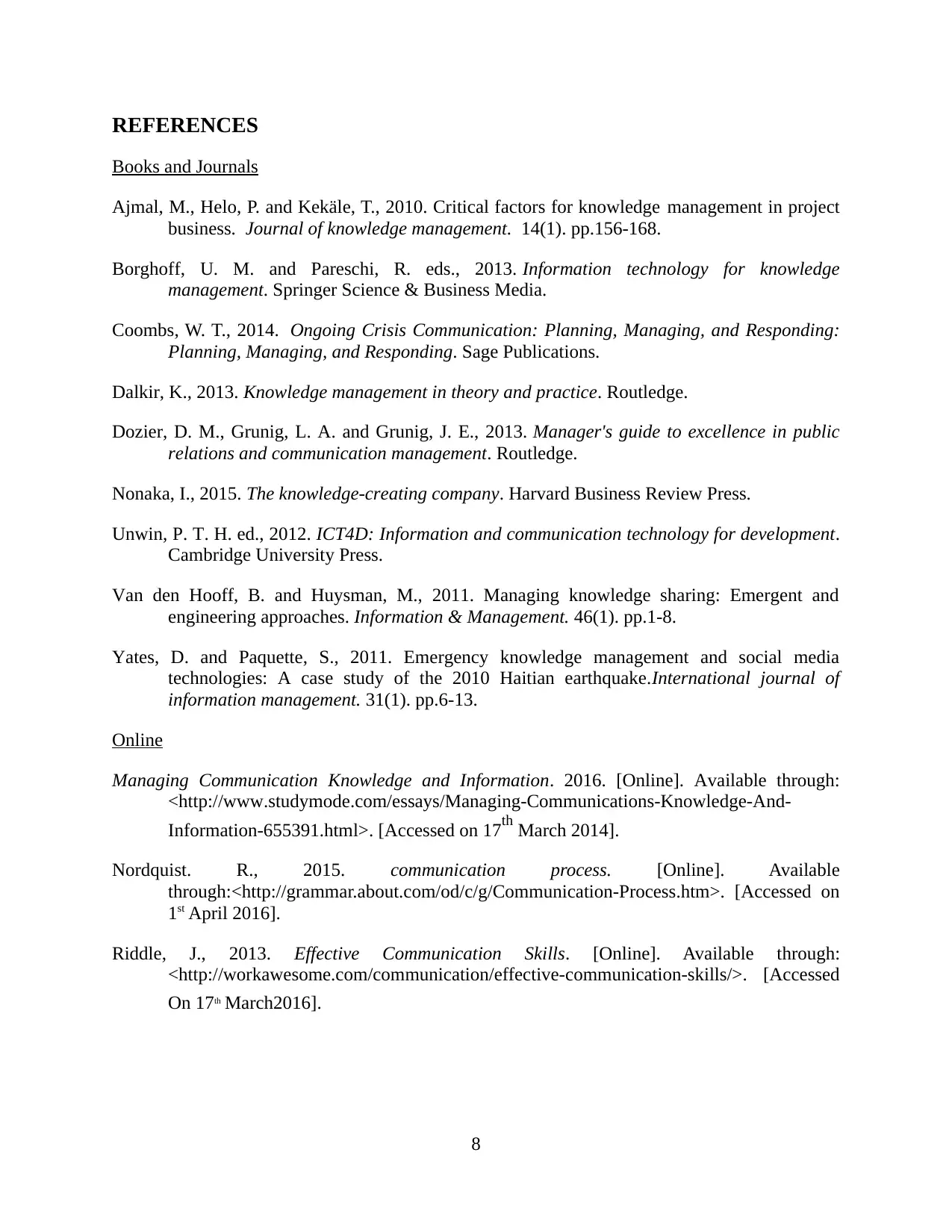
REFERENCES
Books and Journals
Ajmal, M., Helo, P. and Kekäle, T., 2010. Critical factors for knowledge management in project
business. Journal of knowledge management. 14(1). pp.156-168.
Borghoff, U. M. and Pareschi, R. eds., 2013. Information technology for knowledge
management. Springer Science & Business Media.
Coombs, W. T., 2014. Ongoing Crisis Communication: Planning, Managing, and Responding:
Planning, Managing, and Responding. Sage Publications.
Dalkir, K., 2013. Knowledge management in theory and practice. Routledge.
Dozier, D. M., Grunig, L. A. and Grunig, J. E., 2013. Manager's guide to excellence in public
relations and communication management. Routledge.
Nonaka, I., 2015. The knowledge-creating company. Harvard Business Review Press.
Unwin, P. T. H. ed., 2012. ICT4D: Information and communication technology for development.
Cambridge University Press.
Van den Hooff, B. and Huysman, M., 2011. Managing knowledge sharing: Emergent and
engineering approaches. Information & Management. 46(1). pp.1-8.
Yates, D. and Paquette, S., 2011. Emergency knowledge management and social media
technologies: A case study of the 2010 Haitian earthquake.International journal of
information management. 31(1). pp.6-13.
Online
Managing Communication Knowledge and Information. 2016. [Online]. Available through:
<http://www.studymode.com/essays/Managing-Communications-Knowledge-And-
Information-655391.html>. [Accessed on 17th March 2014].
Nordquist. R., 2015. communication process. [Online]. Available
through:<http://grammar.about.com/od/c/g/Communication-Process.htm>. [Accessed on
1st April 2016].
Riddle, J., 2013. Effective Communication Skills. [Online]. Available through:
<http://workawesome.com/communication/effective-communication-skills/>. [Accessed
On 17th March2016].
8
Books and Journals
Ajmal, M., Helo, P. and Kekäle, T., 2010. Critical factors for knowledge management in project
business. Journal of knowledge management. 14(1). pp.156-168.
Borghoff, U. M. and Pareschi, R. eds., 2013. Information technology for knowledge
management. Springer Science & Business Media.
Coombs, W. T., 2014. Ongoing Crisis Communication: Planning, Managing, and Responding:
Planning, Managing, and Responding. Sage Publications.
Dalkir, K., 2013. Knowledge management in theory and practice. Routledge.
Dozier, D. M., Grunig, L. A. and Grunig, J. E., 2013. Manager's guide to excellence in public
relations and communication management. Routledge.
Nonaka, I., 2015. The knowledge-creating company. Harvard Business Review Press.
Unwin, P. T. H. ed., 2012. ICT4D: Information and communication technology for development.
Cambridge University Press.
Van den Hooff, B. and Huysman, M., 2011. Managing knowledge sharing: Emergent and
engineering approaches. Information & Management. 46(1). pp.1-8.
Yates, D. and Paquette, S., 2011. Emergency knowledge management and social media
technologies: A case study of the 2010 Haitian earthquake.International journal of
information management. 31(1). pp.6-13.
Online
Managing Communication Knowledge and Information. 2016. [Online]. Available through:
<http://www.studymode.com/essays/Managing-Communications-Knowledge-And-
Information-655391.html>. [Accessed on 17th March 2014].
Nordquist. R., 2015. communication process. [Online]. Available
through:<http://grammar.about.com/od/c/g/Communication-Process.htm>. [Accessed on
1st April 2016].
Riddle, J., 2013. Effective Communication Skills. [Online]. Available through:
<http://workawesome.com/communication/effective-communication-skills/>. [Accessed
On 17th March2016].
8
1 out of 11
Related Documents
Your All-in-One AI-Powered Toolkit for Academic Success.
+13062052269
info@desklib.com
Available 24*7 on WhatsApp / Email
![[object Object]](/_next/static/media/star-bottom.7253800d.svg)
Unlock your academic potential
Copyright © 2020–2025 A2Z Services. All Rights Reserved. Developed and managed by ZUCOL.





